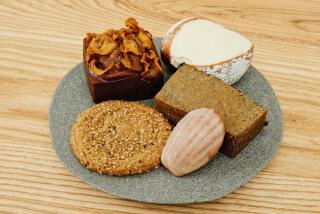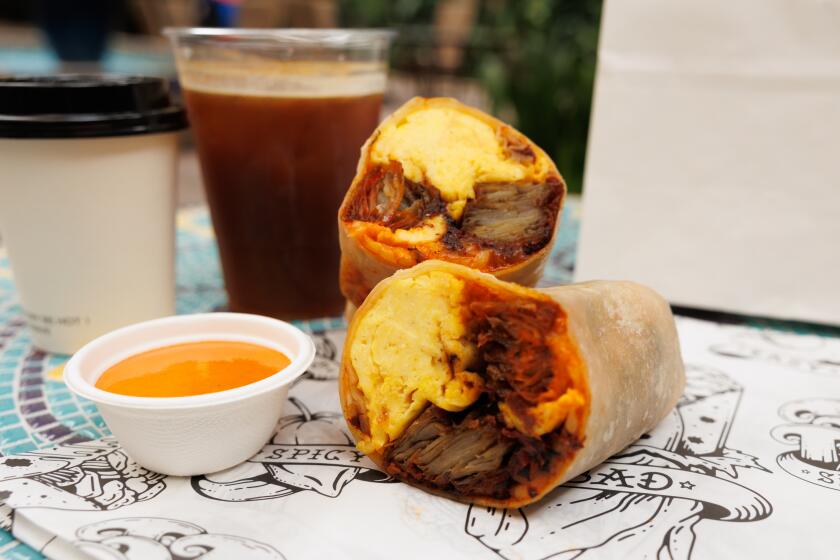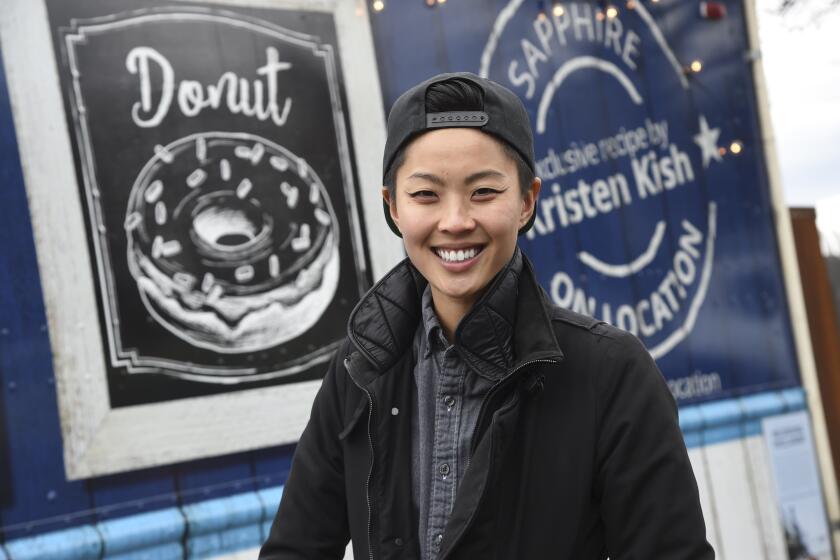Meet the chef cooking up Burmese catfish stew with a side of food art
- Share via
Jessie Nicely’s Instagram handle and former blogging moniker is @youngpoorhungry. Today, it’s an ethos for how Nicely is carving out her niche in Los Angeles’ food community. The 29-year-old half-Burmese chef hosts traveling pop-ups called “Burmese, Please” (often alongside Yarrow Cafe and Pique Nique LA) in Far East Plaza in Chinatown, where she offers riffs on traditional Burmese dishes for $10 or less. Nicely is also the co-founder of the food art zine Compound Butter, which covers topics ranging from animal feet meat to children’s tables at restaurants, and employs funky fonts and illustrations by her cousin and collaborator, Jaya Nicely.
How did you start Compound Butter?
After college, I worked in educational HR. After a few years of feeling unsatisfied by it, I kind of made a rushed decision and went to culinary school at a community college.
I was working as a pitmaster and sous chef at a restaurant in the Bay Area — as a woman and a woman of color, I had to compensate to feel I was on the same level as my peers... which isn’t the most original story, but it was true. I wanted to feel in control and not taken for granted. Eventually I moved down to Los Angeles and got closer with my cousin Jaya, who had grown up there. She was in school studying art and illustration, and we started discussing ways we could combine our interests.
How does one launch a food-art magazine?
The first issue we ever did was for Jaya’s class project, where she had a prompt to work on the same printed material for a year. At first, we wrote it all ourselves, and then it was a lot of just texting friends, asking them if they’d be a part of it. ‘Food magazine’ is a loose description; we have a lot of pieces that are personal narratives or memoirs through food: one about going to White Castle or eating at all the places Anthony Bourdain ventured to before his passing. A thing that was really important to us was to be accessible to people who wouldn’t describe themselves as foodies.
Humor seems to play a big role in it too.
Jaya and I both grew up watching Wallace and Gromit and Miyazaki films, always really obsessed with the way that food was depicted in cartoons. With the arrival of Lucky Peach, there was this bubbling open of food and design, that for the first time put all of these food and art things into something manageable and packaged. There’s so much of it now. I love Lazy Mom’s photography. I’m so happy that food is now prevalent and people are excited by it. And “Chicken Run,” oh my God, is it bad that that movie made me want chicken?
You traveled to Burma before starting your pop up series. How did actually going to Burma influence the way you saw yourself in the food world?
It’s funny, all my white friends were like, “Let’s go to Burma on vacation!” And I was like, “Ugh….” But eventually, I went to Burma kind of hoping to find some part of myself I thought was missing. I’m pretty ambiguous-looking. Growing up, many people in the Bay Area assumed I was Latina. Later, I went to Burma with my mom to see our family we hadn’t ever met. I wanted to feel like, “These are my people.” But I didn’t get that. I was taller and fatter than a lot of people there.
Coming down to Los Angeles, there was a story of the cuisine that definitely hadn’t be told. There’s this whole wave of second-generation kids that didn’t necessarily think about the food they grew up with until they got older. I’m excited to be apart of that, even in a small way.
Do you see a crossover in your desire to explore Burmese food in your pop-ups and the stories that fascinate you for the magazine?
I’ve written a couple times about my own racial struggles — I’m half-white and half-Burmese. Growing up, I just identified as white because I didn’t know or see any other Burmese people. My mom [who is Burmese] has seven brothers and sisters, and everyone specialized in different dishes.
I discovered how to make mohinga from a Burmese neighbor. It’s a catfish chowder, which is the Burmese national dish, with boiled egg and fried garlic. Working on my pop-ups, it’s been half reacquainting myself with these recipes, while doing some riffs.
There’s sort of this mystique around these creative, flexible spaces in food, that makes it seem like everyone’s profitable or supporting themselves just off of that. Is this the case for Compound Butter?
We definitely don’t make any money from it. These days, I work as a full-time database programmer, and Jaya works as an art director for a publishing house. But there’s certainly an audience looking for this content. We’ll get people calling us to intern, and we’re like, it’s just two of us. We try to keep it reasonable for what to expect for our contributors, though Instagram does give a certain façade of success.
More to Read
Eat your way across L.A.
Get our weekly Tasting Notes newsletter for reviews, news and more.
You may occasionally receive promotional content from the Los Angeles Times.









